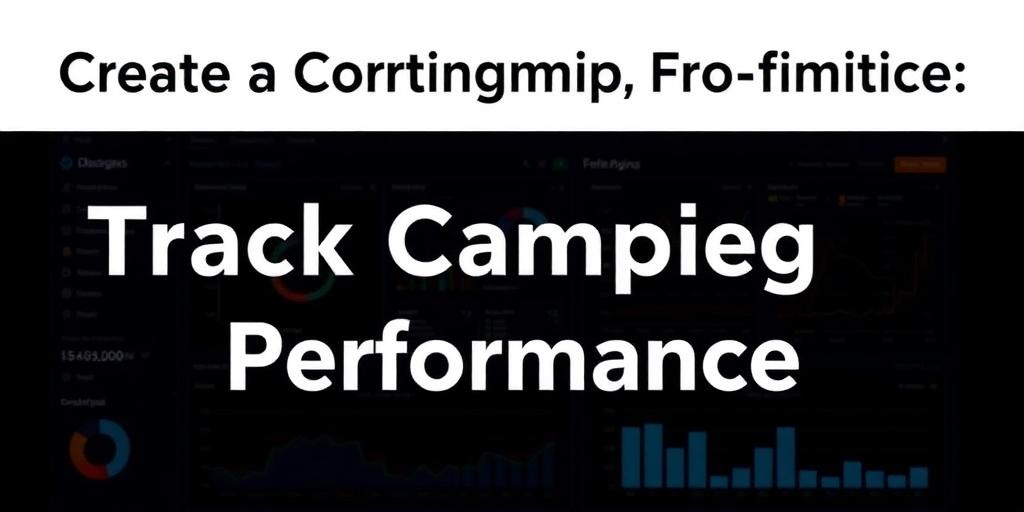In today's data-driven landscape, understanding how to meticulously track campaign performance is no longer a luxury, but a necessity for marketers and business owners alike. The ability to discern which strategies are yielding results and which are falling short is crucial for optimizing your marketing spend and maximizing your ROI. This post provides a comprehensive guide to tracking campaign performance like a seasoned professional.
1. Define Clear Objectives and Key Performance Indicators (KPIs)
Before launching any campaign, it's imperative to define crystal-clear objectives. What specific goals are you trying to achieve? Are you aiming to increase brand awareness, generate leads, drive sales, or boost customer engagement? Once your objectives are defined, identify the KPIs that will serve as benchmarks for measuring progress. Common KPIs include:
- Click-Through Rate (CTR): Measures the percentage of people who click on your ad or link after seeing it.
- Conversion Rate: Tracks the percentage of visitors who complete a desired action, such as making a purchase or filling out a form.
- Cost Per Acquisition (CPA): Calculates the cost of acquiring a new customer.
- Return on Ad Spend (ROAS): Measures the revenue generated for every dollar spent on advertising.
- Website Traffic: Monitors the number of visitors to your website.
- Engagement Metrics: Tracks likes, shares, comments, and other forms of social interaction.
2. Implement Robust Tracking Tools
To effectively track campaign performance, you need to leverage the right tools. Several options are available, each offering unique features and capabilities. Some popular choices include:
- Google Analytics: A free web analytics service that provides valuable insights into website traffic, user behavior, and conversion rates.
- Google Ads: Google's advertising platform offers comprehensive tracking tools for monitoring ad performance, including impressions, clicks, conversions, and cost-per-click (CPC).
- Social Media Analytics: Platforms like Facebook, Instagram, Twitter, and LinkedIn provide built-in analytics dashboards that track engagement metrics, reach, and audience demographics.
- Marketing Automation Platforms: Tools like HubSpot, Marketo, and Pardot offer advanced tracking features, including lead scoring, email marketing analytics, and campaign attribution.
3. Utilize UTM Parameters for Granular Tracking
UTM (Urchin Tracking Module) parameters are short text codes that you add to your URLs to track the source, medium, and campaign associated with each visit. By using UTM parameters, you can gain a deeper understanding of which marketing channels are driving the most traffic and conversions. UTM parameters typically include:
- Source: Identifies the source of the traffic (e.g., google, facebook).
- Medium: Specifies the marketing medium (e.g., cpc, email, social).
- Campaign: Names the specific campaign (e.g., summersale, productlaunch).
4. Create Comprehensive Reports and Dashboards
Regularly generate comprehensive reports and dashboards to visualize campaign performance data. These reports should include key metrics, trends, and insights that help you understand what's working and what's not. Use data visualization tools to create charts, graphs, and tables that effectively communicate your findings. Share these reports with stakeholders to keep everyone informed and aligned.
5. Analyze Data and Identify Areas for Improvement
Data analysis is the cornerstone of effective campaign tracking. Take the time to thoroughly analyze the data you've collected, identify patterns and trends, and draw actionable insights. Look for areas where performance is lagging and investigate the underlying causes. Are your ads targeting the right audience? Is your landing page optimized for conversions? Are your email open rates declining? By identifying areas for improvement, you can make data-driven adjustments to your campaigns and maximize their effectiveness.
6. Implement A/B Testing to Optimize Performance
A/B testing, also known as split testing, involves comparing two versions of a marketing asset to see which one performs better. A/B testing can be used to optimize various elements of your campaigns, including ad copy, landing pages, email subject lines, and call-to-action buttons. By systematically testing different variations, you can identify the most effective strategies and continuously improve your results.
7. Stay Agile and Adapt to Change
The marketing landscape is constantly evolving. New technologies, platforms, and trends emerge regularly, requiring marketers to stay agile and adapt to change. Continuously monitor your campaign performance, stay informed about industry best practices, and be willing to experiment with new strategies. By embracing a culture of continuous learning and improvement, you can ensure that your campaigns remain effective and competitive.
By following these steps, you can transform your approach to campaign performance tracking. The insights gained will empower you to make data-driven decisions, optimize your marketing investments, and achieve your business objectives with greater precision and effectiveness.









